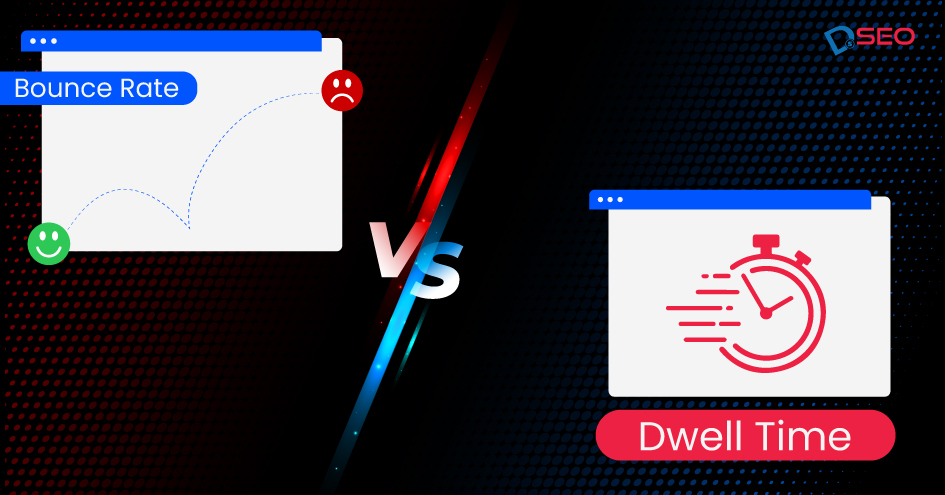
What is the Difference Between Dwell Time and Bounce Rate in SEO?
February 29, 2024 / SEARCH ENGINE OPTIMIZATION
So, what do you do whenever you use Google? You put your query or some keywords to get the answers, right?
After getting a search query, you get a SERP page. You must prefer clicking on the top-ranking site rather than bothering yourself by scrolling down to the second page. But what if even the first-ranking site is unable to fulfill your query?
Well, it’s obvious to get back on the SERP and choose the second or third-top-ranking sites. Here, we get the concept of dwell time and bounce rate in SEO. You have a site that is getting visitors, but instead of engaging more, completely satisfied, or going to the other pages of your website, they simply get back after visiting a single page—it’s a bounce.
The percentage of such visitors is known as your site’s bounce rate, and the time an individual spends on your web page is known as dwell time. If 70% of users have visited your site like this, your bounce rate is 70%, and if the time they spent there is 20 seconds, your dwell time will be 20 seconds.
Dwell time and bounce rate are the two most important things in SEO that tell you about the performance of your site. So, if you want your ranking to be good, you need to practice optimization for these two. But before all that, you need to know what dwell time and bounce rate actually are.
What is Dwell Time? Why Does It Matter for SEO?
In 2011, the dwell time was first mentioned by Bing as “a signal we watch” for the measurement of the quality and audience engagement of a page.
However, it’s not a confirmed Google ranking factor, but it’s a key performance indicator (KPI), which is very important to make things better.
If you have less dwell time, it doesn’t mean that your content isn’t as good as it should be. It may be possible that the user query isn’t answered in the first paragraphs, or they are looking for something else. There are different search intent of different users. But if the average dwell time is always low on your site, you need to give it some attention.
Moreover, a low dwell time in SEO can impact the machine learning algorithms of Google or other search engines, and it can significantly lower your rankings.
How Do I Check Dwell Time in GA4?
Well, there is no specific formula to calculate dwell time in SEO, but you can check it via average session duration in Universal Analytics (UA) or Average Engagement Time in GA 4.
Note: Universal Analytics refers to the previous generation of Google Analytics
The average session duration measures how long the user spends on the whole site rather than one page. On the other side, Average Engagement Time is the average time a user engages in a webpage and is calculated as a sum of user engagement durations per user.
Here’s a step-by-step guide to understanding and analyzing the Average Engagement Time metric in Google Analytics 4 (GA4):
Step 1: Log in to your GA 4 or Analytics account using your credentials.
Step 2: Once logged in, you’ll be directed to the GA4 dashboard. Navigate to the “Reports” section using the left-hand sidebar menu.

Step 3: Within the Reports section, follow “Reports> Engagement> pages and screens.

Step 4: Locate and select the metric labeled “Average Engagement Time.”

What is Bounce Rate? Why Does It Matter for SEO?
The bounce rate is the percentage of visitors who simply leave the site without taking any action. No clicks on other links, no purchases, no signing up, and no comments or feedback. Bounce rate is closely related to Google rankings.
The average bounce rate usually lies between 41% and 51%, and if your bounce rate is above 80%, it’s an indication that you need to improve your page, content, UX, or UI. But the bounce rate and its value depend on various niches and your targets.
For example, eCommerce & retail usually have a 20-45% bounce rate, while landing pages and blogs have 60-90%.
Moreover, it also depends on the site’s traffic and its sources. Display ads and social media traffic have the highest bounce rate of around 55%, while referrals & emails have around 35%.
How is the Bounce Rate Calculated in GA4?
In UA, the bounce rate is only dependent upon user interaction, but in GA4, it is measured on the basis of user engagement measures like page views, session duration, and conversion events. You can also analyze the bounce rate on the basis of its opposite engagement rate.
To check the bounce rate in Google Analytics (GA4), here are the steps to follow.
Step 1: Log in to your (Analytics) GA4 account and go to the left-hand side menu bar. After that, simply click on the “Reports” tab.
Step 2: Click on “Engagement” and then select “Pages and screens.”
Step 3: Use the pencil icon located on the top right corner of your screen to customize the report.
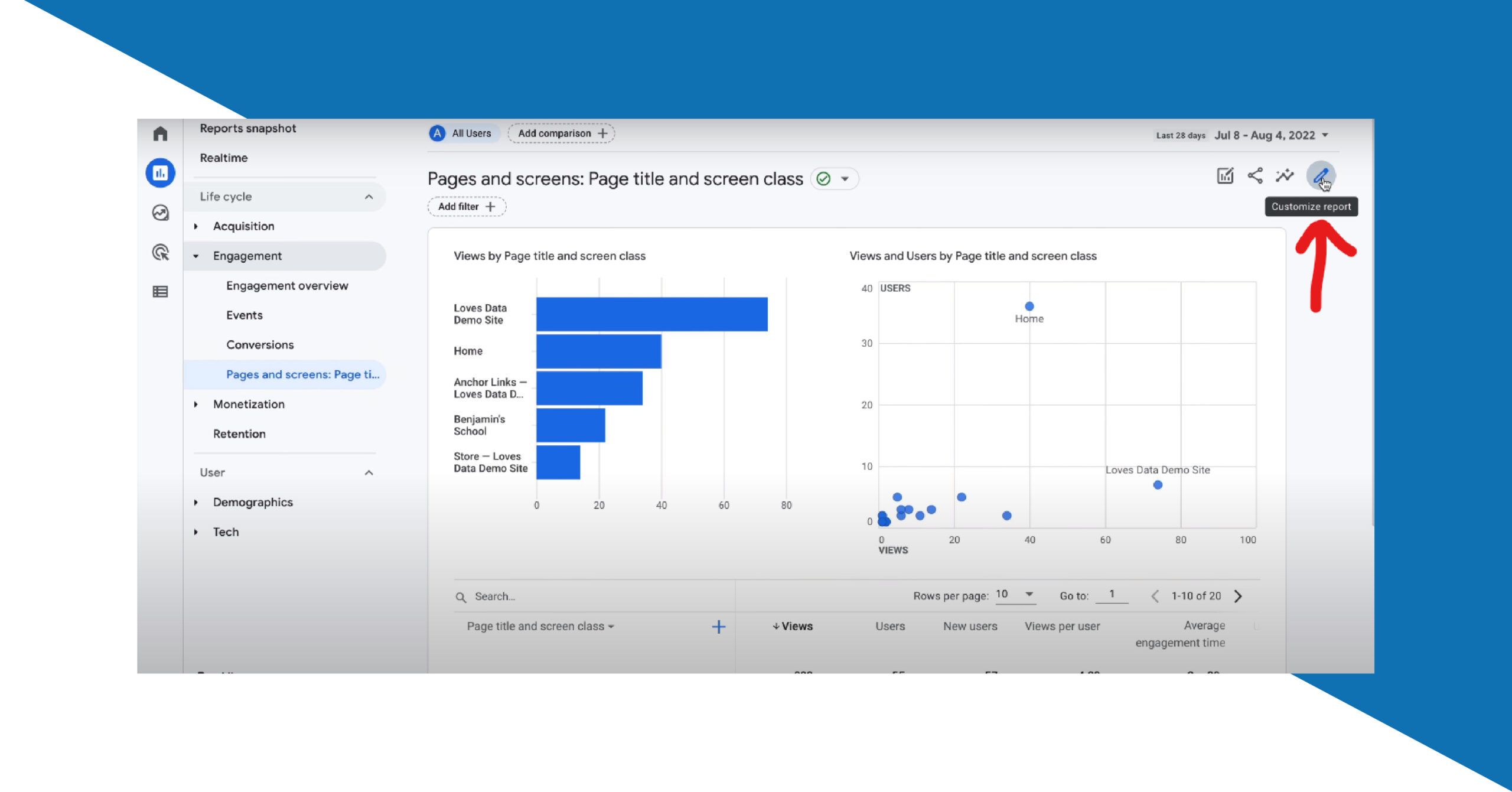
Step 4: In the sidebar that appears on the right, choose “Metrics.”
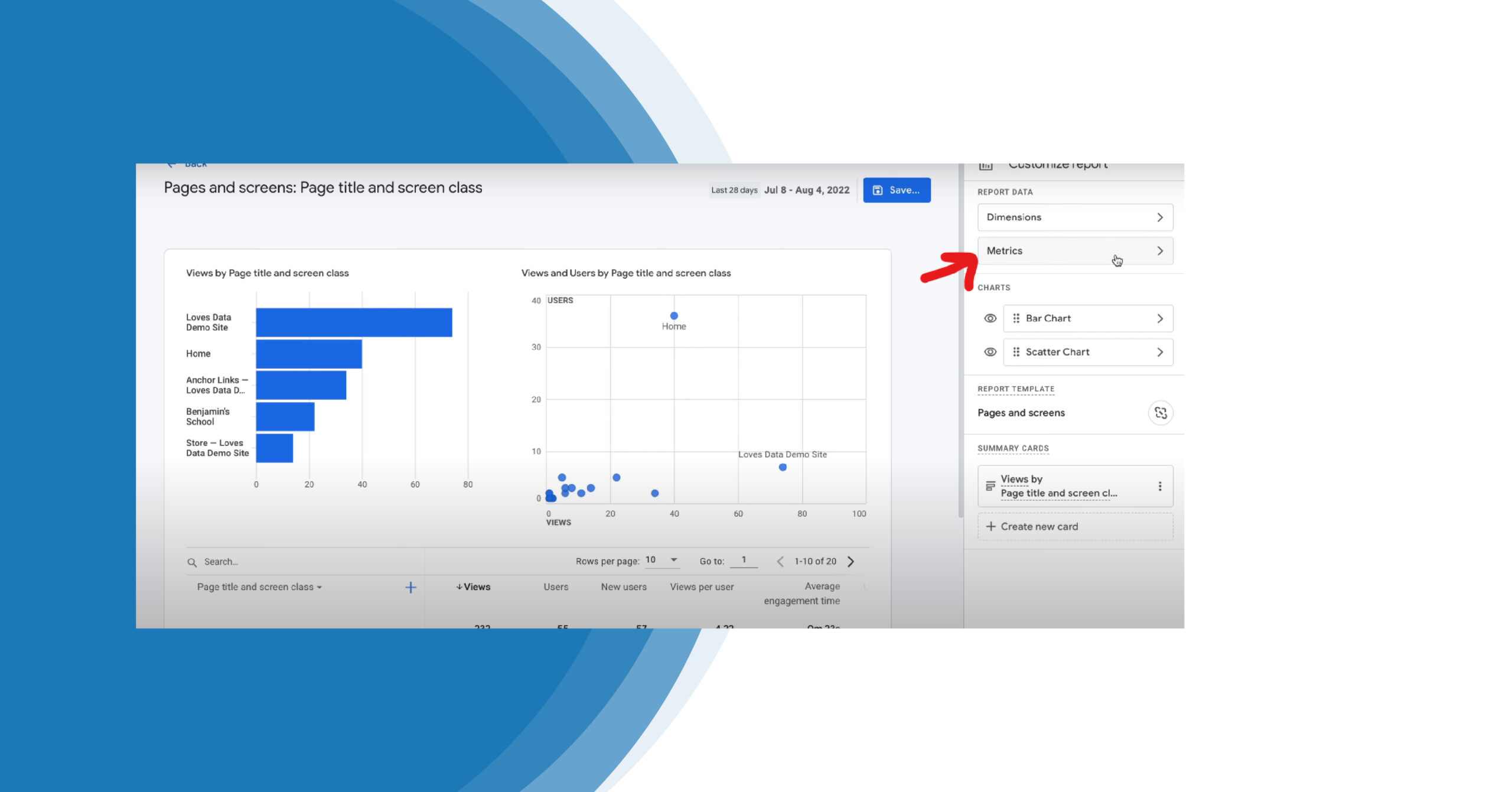
Step 5: Click on “Add metric” at the bottom of the sidebar. Select “Bounce rate” from the list.

Step 6: Click and drag the six dots next to “Bounce rate” to move it up so that it’s one of the first columns in the report.
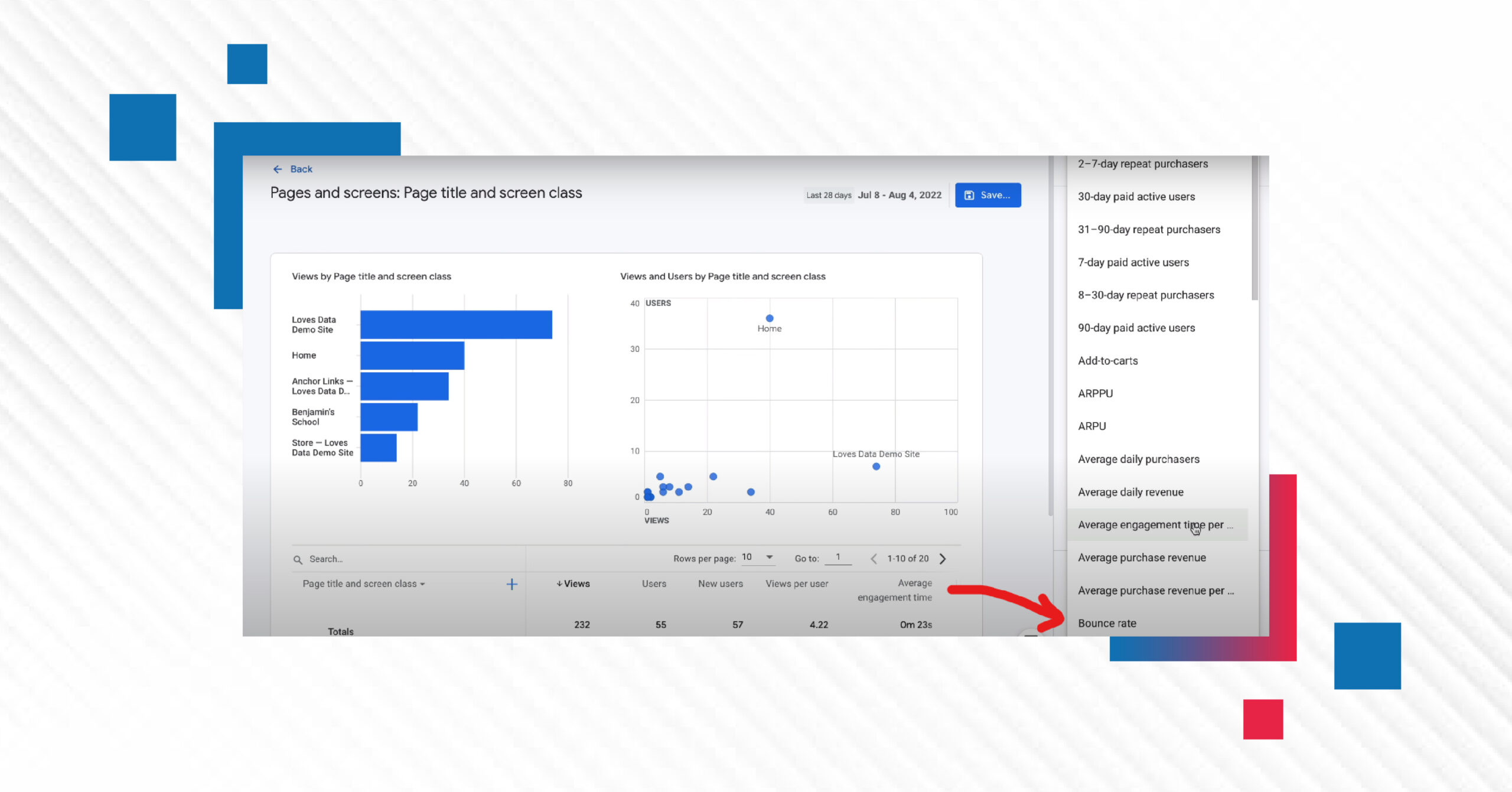
Step 7: Click on “Apply” to confirm your changes.

Step 8: Click on “Save” and then select “Save changes to the current report.” Finally, click “Save” to save your changes. Navigate back to the report to ensure that the bounce rate is now included.

Dwell Time vs. Bounce Rate
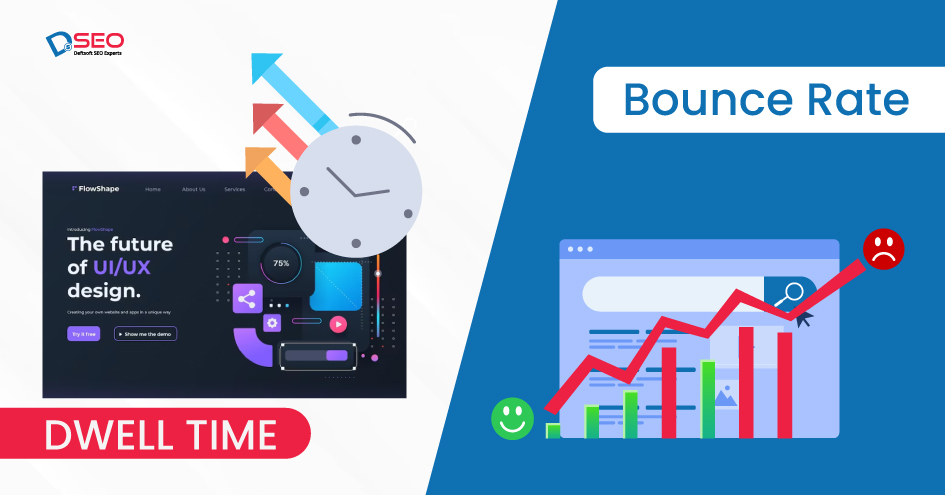
After all this discussion, I hope you had a clear understanding of dwell time and bounce rate. So, talk about how they are different from each other to make our knowledge even better from the point of view of SEO.
If you’re in a hurry, here’s a quick overview of it.
|
Criteria |
Dwell Time |
Bounce Rate |
|
Definition |
The amount of time a user spends on a webpage or content before navigating away or returning to search results. |
The percentage of the audience leaving a website after visiting only a single page, without interacting or navigating to other pages. |
|
Measurement |
Measured in seconds or minutes. |
Measured as a percentage. |
|
Significance |
Indicates user engagement and the quality of the content. Higher dwell time often suggests valuable and relevant content. |
Indicates how well a webpage retains visitors. A lower bounce rate generally indicates and shows that visitors find the content relatable and engaging. |
|
Interactivity |
May not necessarily involve interaction with the page (e.g., reading an article without scrolling or clicking). |
Indicates whether users are exploring multiple pages on the website or leaving after viewing just one. |
|
SEO Impact |
Generally considered a positive signal for search engines, as it suggests that users find the content valuable. It may contribute to higher search rankings. |
A lower bounce rate is generally seen positively by search engines, as it indicates that users are finding what they need and engaging with the site. |
|
Examples |
Reading a blog post from start to finish. |
Landing on a webpage and immediately clicking the back button. |
|
Factors Influencing |
Content quality and relevance. |
Page load speed. |
|
Optimization Tips |
Create high-quality, engaging content. |
Improve page layout and user experience. |
|
Limitations |
Doesn’t account for time spent on interactions like scrolling or watching videos without interacting. |
Doesn’t consider the time spent on a page; a user may spend a long time reading a page and still be counted as a bounce if they don’t navigate to another page. |
Now, let’s move on to the details!
1. SEO Impact
If you have been reading this blog from the beginning, you already spent 5 minutes. It means you found this post interesting, isn’t it?
Here, the dwell time is pretty good, but I can’t say anything about the bounce rate. If you haven’t clicked any links, didn’t leave any comments, or take any action, you have certainly increased the bounce rate of my page.
In terms of SEO, if you ask which one is most important. It’ll be a tricky question to answer as the measurement of both metrics can be highly or almost equally profitable and wise.
2. Calculation
It’s important to keep in mind that dwell time isn’t an actual concept by Google or GA4, and you’re simply going for its average values rather than per individual time. However, we use this concept for the site owners to improve their SEO engagement.
But in the case of bounce rate, things are more straightforward. You can simply check the bounce rate in Google Analytics (GA4) directly.
A longer dwell time generally suggests that users find the content valuable and engaging, which can positively affect search engine rankings and user satisfaction.
A high bounce rate can showcase that visitors are not finding what they’re looking for or that the landing page doesn’t meet their expectations. It can negatively impact factors in search engine rankings and conversions.
What is a Good Dwell Time and Bounce Rate in SEO?
Well, there’s no standard definition of a good bounce rate. It can vary based on some factors, such as industry, type of website, target audience, and content type. For E-commerce websites, the range between 20% and 40% might be considered good. For content-focused websites, it can be 40% – 60%, and for landing pages, it should be below 70%.
Similar to bounce rate, what constitutes a “good” dwell time can vary depending on factors such as the type of website, content, and user intent. Generally, a longer dwell time in SEO is preferable. However, it’s okay if you sometimes get a low average engagement rate (as you can’t actually measure dwell time).
Bottom Line
In the end, I would like to remind you that SEO and Google rankings depend on multiple and endless factors. Dwell time and bounce rate are one of them.
It seems pretty hard to follow all these factors but the reality is that 95% of those factors aren’t officially listed by Google. For good rankings, Google only talks about the relevance of content, quality of content, usability of web pages, context, and helpfulness. Neither dwell time nor bounce rate can exactly, directly, and instantly affect your site. Undoubtedly, they are good metrics to track the performance of your site and web pages. If you always get less dwell time and a higher bounce rate, it’s an indication to change your strategies.
Moreover, Google and other search engines are also evolving with time, and their ML algorithms are getting more advanced. In such scenarios, optimizing each ranking factor and content or page quality is highly important.
I hope you loved reading here. If this post is helpful for you, share it with your team and SEO executive buddies. Have a nice day!
Frequently Asked Questions (FAQs)
Is a 0% bounce rate good?
It is simply too good to be true. In case you are getting a zero-bounce rate, there are possibilities that you have a massive number of visitors performing any action, your visitors are directly visiting the inner pages, your website has any technical issues, or the pages users are visiting are not landing pages.
Does dwell time affect indexing in Google?
There’s no evident proof that explains that dwell time affects Google indexing. This term is made for site owners to track the progress of their site.
What is the difference between exit rate and bounce rate?
Exit rate is the measure of the percentage of users who simply leave a website from a specific page after exploring other pages. On the other side, bounce rate is the measurement of the percentage of users who leave a website after visiting or scrolling only a single page.








